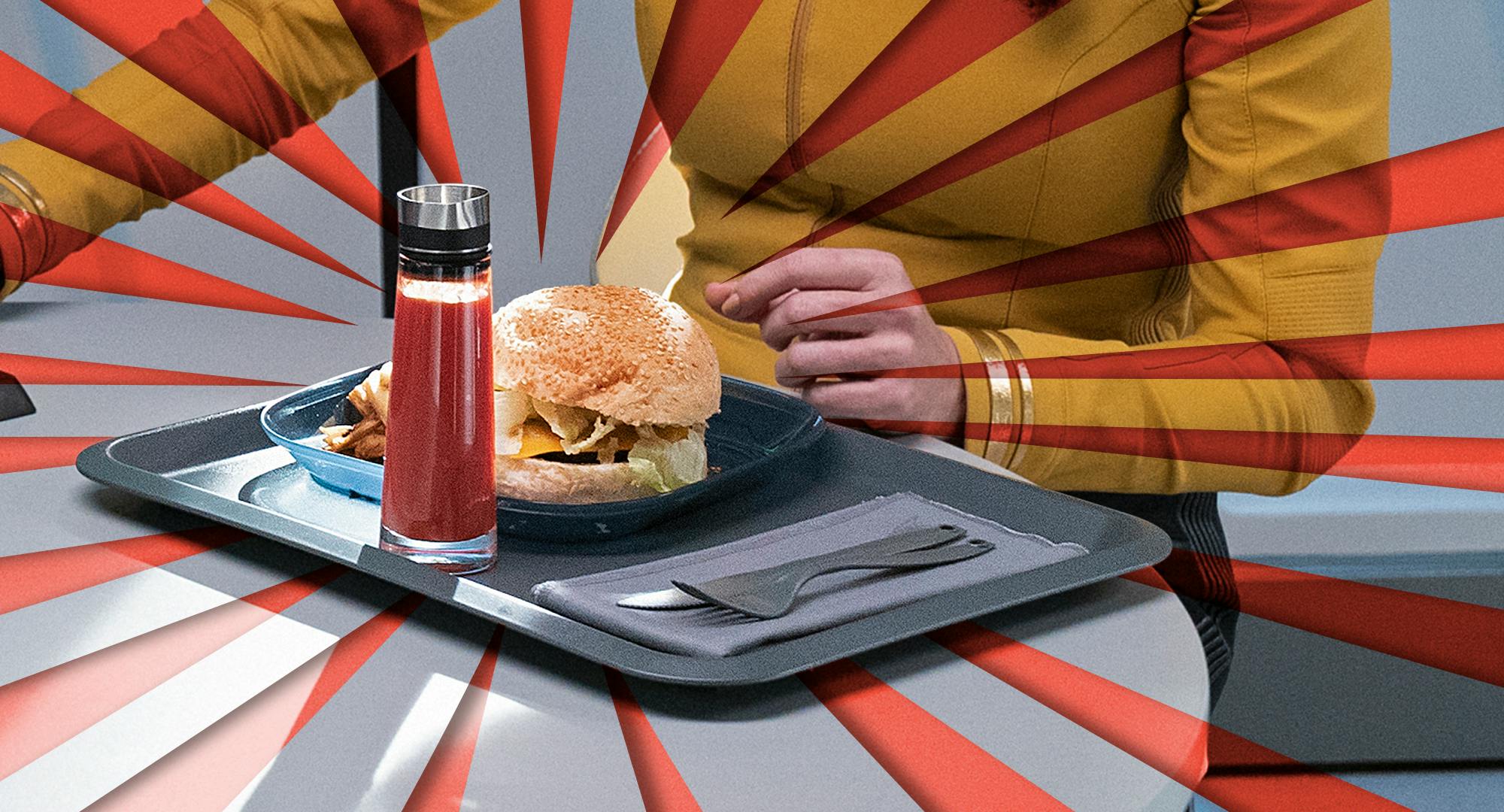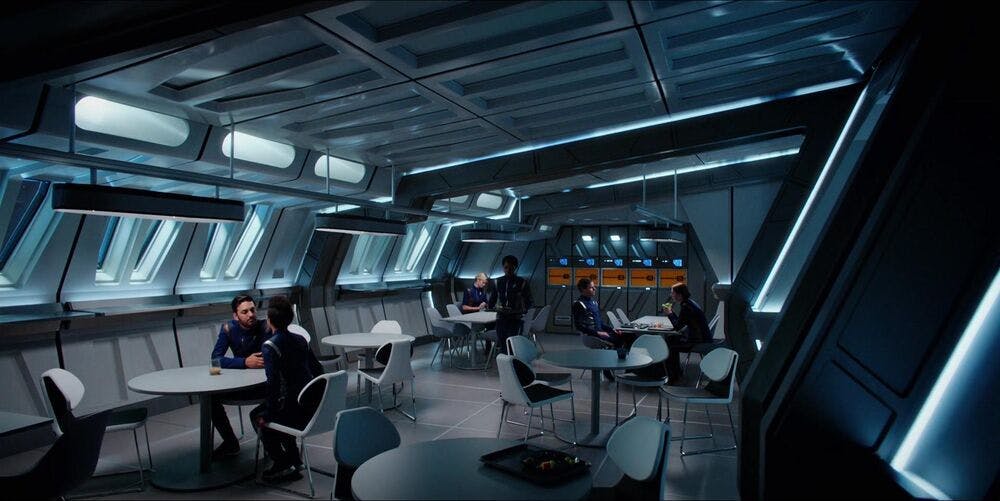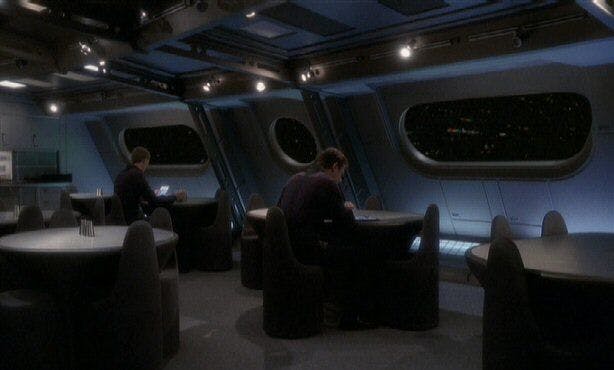Published May 21, 2021
Eating on the Enterprise: The Psychology of Food in Trek
In Starfleet everyone has something to eat, fueling the utopia of the Federation.

StarTrek.com
In any Star Trek series set on a Starfleet vessel, you’re likely to grow familiar with certain archetypical scenes: those set on the bridge, those in Engineering, and those scenes in the shuttle bay. However, there’s one such archetypical scene that seems to be often overlooked: the mess hall!
Not to be a Migleemo, but there’s a reason that we see so many scenes of the crew eating: access to food is a fundamental facet of the foundation of the Federation. Between providing necessary nutrition, offering social and community building benefits, and serving as a fundamental way to know and be known, food is a key part of the utopia of the Federation.
Nice to Eat with You

StarTrek.com
Almost every Trek show features scenes of the crew in the mess hall eating. Frequently, each of the crewmembers is eating an unique meal, in accordance with their dietary needs, culinary preferences, or both.
From a narrative perspective, these scenes can be important for moving the plot forward, particularly when it comes to storylines that are entered on the crew’s personal or social lives. However, the fact that each member of the crew can be assured that they will be fully fed each day is more significant than it might seem at first taste.
Everyone knows that Starfleet represents humanity at our best, but in order to achieve such lofty accomplishments, effective foundations must first be laid. In order for people to perform at full capacity, they need to be fed. Situations in which not everyone can get the food they need, or food insecurity (a term meaning at least one member of a family isn’t getting enough nutrition to be healthy), can dramatically affect performance.
For example, a 2019 study on chronic absenteeism in elementary schools conducted by the University of California Santa Barbara found that when breakfast was provided after the morning bell, student absences dropped six percent.
And ensuring everyone is fed also serves the greater good. For example, Donna Carver, who works with No Kid Hungry Georgia, notes that when kids aren’t hungry, there’s less fighting. A reduction in conflict means more time to work together toward meaningful goals. When Afterschool Meal Programs exist, students enjoy even more benefits, including increased participation in afterschool activities, better focus, and better overall performance.
Why is access to food so closely linked with performance? Eating certain foods can have a direct effect on brain function. For example, a 1982 study authored by Richard J. Wurtman found that tryptophan, tyrosine, and choline are nutrients which are found in some foods, and which serve as the precursors for neurotransmitters. By increasing the amount of these nutrients consumed, the synthesis of the corresponding neurotransmitters can be consummately enhanced. By extension, this means that more transmitter molecules may be released by a neuron, which can result in the creation of new connections in the brain.
On a related note, as a glucose-dependent organ, the brain needs sugar in order to function, and when glucose isn’t available – including in cases of food insecurity – cognitive dysfunction can be the consequence, having an effect on one’s concentration.
In other words, when everyone is fed, everyone is able to perform better. But it isn’t just performance that benefits: food builds community, as well.
The Captain’s Table

StarTrek.com
In many different Trek shows, we see how food is used to build community.
One example is the dinners that we see Captain Kathryn Janeway and First Officer Chakotay share over the course of Voyager. These private dinners give the two leaders the opportunity to build trust with one another — an essential component of their relationship, considering they began as the captains of two different crews that must integrate into a single community in order to survive the Delta Quadrant.
And on Enterprise, we see Jonathan Archer host several members of the NX-01’s crew for private breakfasts at the Captain’s Table. These meetings serve to allow Archer to become better acquainted with those serving alongside him on the ship. Part of what accomplishes this goal comes thanks to the social elements which naturally follow sharing a meal: for example, sharing dinner gives T’Pol the opportunity to share a story about her great-grandmother, a personal (and possibly apocryphal) tale that she may not have had a chance to tell while undertaking other essential Enterprise operations.
Another facet of food that is clearly demonstrated throughout ENT is the way that the culinary arts can be an essential component in the process of getting to know strange, new cultures — not to mention in letting them get to know ours.
Plus, food can even be an essential element in democracy, especially in the early days of connection with extraterrestrial cultures, as when the NX-01’s chef prepares traditional Tellarite foods for an ambassador visiting the ship, with the meal being consumed underscoring the shared goals between the Enterprise crew and the alien ambassadors. Alternatively, differences in dietary habits can be used to become better acquainted with other cultures, as seen when the Vissians compare and contrast the human cheeses proffered by the NX-01’s crew against their own pungent cheeses.
Just how integral can food be in personal connection? We see one example of this in the Short Treks episode “Runaway,” in which we see how Ensign Sylvia Tilly accomplishes first contact with Queen Po thanks to ice cream. In fact, because the dessert is a catalyst for their mutual respect for one another, when Tilly and Po are reunited in the Discovery episode “Such Sweet Sorrow,” Tilly is waiting for Po’s arrival with spumoni ice cream already in hand… and in spite of the serious circumstances surrounding their reunion, this effort is recognized by Po, who takes time to discuss the food with her friend.
You want to order some lighter fluid with that?

StarTrek.com
It is impossible to discuss food on Trek without considering the miraculous replicators. Capable of synthesizing a huge spectrum of foods, from spicy habanero cheeseburgers to nutrient pellets, this invention is an important part of making food accessible in Starfleet.
Naturally, the replicator is not a reality (or not yet, anyway… although with more advances in synthetic meat all the time, perhaps they aren’t so far off). However, while such an invention may not yet exist, feeding everyone is still a worthy goal to strive towards.
And Trek already has examples of how food is handled when the replicators are off-line, or when limited resources make replicator rationing necessary. On board Voyager in the Delta Quadrant, Neelix went to great effort to provide specific foods to the crewmembers, especially when he knew that there were cultural culinary traditions at play. Furthermore, as Neelix learns more about these culinary practices in order to better serve the non-nutritional food-related needs of his fellow crewmembers, by his own admission, he also learns more about their respective cultures.
All hands to the mess

StarTrek.com
While the Federation is commonly accepted to show humanity if we could put aside our differences, access to food may be one of the most underrated aspects – but it’s also one of the most fundamental building blocks of the best of all possible worlds.
If everyone’s fed, conflict is minimized, no one is distracted from learning by hunger, and everyone has the ability to contribute their best effort — and that’s better for all of us!
Avery Kaplan (she/her) is the Features Editor at Comics Beat. You can also find her writing on NeoText, Shelfdust, and Comics Bookcase, in many issues of the Eisner Award-winning PanelxPanel, and in the margins of the books in her personal library. She was honored to serve as a judge for the 2021 Cartoonist Studio Prize Award. Find her on Twitter @averykaplan6

